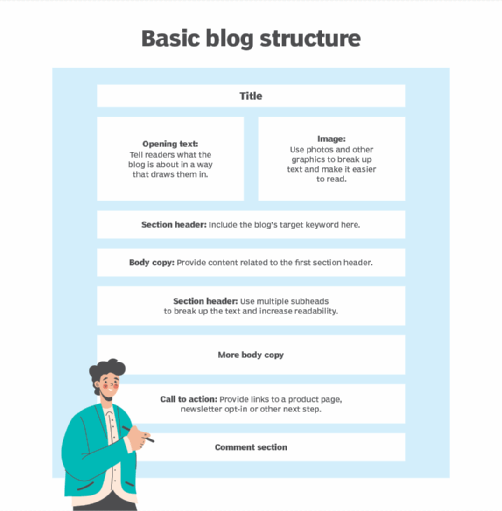Table of Contents
Introduction
Blogging has evolved from its early days as a personal diary to a key component of digital marketing strategies. Blog posts serve multiple purposes, from expressing personal opinions to generating organic traffic through search engines, establishing a strong online presence, and building an online community. But what exactly is a blog post? How should you use it to achieve your goals? In this post, we’ll explore what blog posts are and how to use them effectively.
What Is a Blog Post?
A blog post is a piece of content published on a website, often as part of a larger blog. It can range from short reflections to long, informative pieces on a variety of topics. Blog posts can include text, images, videos, and even links to other forms of media like podcasts. They can be opinion-based, informative, or a mix of both. While blog posts started as a way for individuals to express themselves through personal blogs, they have grown into powerful tools for businesses, influencers, and professionals to reach a wider audience, connect with readers, and drive traffic to their websites.
The Evolution of Blogging
Blogging has come a long way since Justin Hall created what is widely considered the first blog back in 1994. Originally, blogs were akin to personal diaries shared online. Over time, however, they became more formalized, with professional bloggers emerging and large corporations using blogs as part of their marketing strategies.
Today, blogs can be found on virtually every blogging platform from WordPress to Medium. Whether you’re using a self-hosted WordPress blog or a simple hosted solution, the goal of blogging remains consistent: to provide relevant content that appeals to a particular audience.
The Role of Blog Posts in Digital Marketing
Blog posts have a significant role in search engine optimization (SEO) strategies. When written with a strategic plan, blog posts can help websites rank higher on search engines, driving traffic from search engines like Google and Bing. This organic traffic is essential for businesses looking to build an online presence without paying for ads.
Moreover, blogging allows businesses to showcase their expertise and provide valuable informative content to their audience. Regular, relevant content updates help websites stay fresh and appealing to both readers and search engines.
Types of Blog Posts
There are various types of blog posts that can be written depending on the blog’s niche, audience, and goals. Some common types include:
- Informational posts: These are designed to educate the reader on a particular topic, often including guides, lists, and how-to articles.
- Opinion posts: These express the blogger’s personal views on a subject matter, encouraging debate and interaction with readers.
- **Travel blog: Bloggers write about their travel experiences, offering insights and advice for potential travelers.
- Recipe blogs: These focus on sharing recipes and cooking tips, often incorporating step-by-step guides and images.
- Ultimate Guides: Comprehensive, in-depth resources on a particular subject.
By offering a variety of topics within a blog, readers are more likely to return to see fresh content.

How to Use Blog Posts Effectively
1. Establishing a Strategic Plan
Before diving into blog writing, it’s essential to have a strategic plan in place. Every blog post should have a goal in mind, whether that’s driving traffic, generating leads, or fostering a sense of community. Establishing an editorial calendar can help plan content on a regular basis, ensuring that fresh blog content is posted consistently.
2. Choose the Right Blogging Platform
Selecting the right blogging platform is crucial for success. For those looking for complete control over their blog’s design and content, self-hosting a WordPress blog offers flexibility and a wide range of blog themes and blog layouts to choose from. However, platforms like Medium and Blogger also offer straightforward options for those looking for simplicity.
For a truly well-designed blog, a self-hosted WordPress blog allows for maximum customization. Once you’ve chosen a blog host and installed your blogging software, you can begin personalizing your site by selecting a blog theme and working with blog layouts to create a beautiful blog.
3. Create Relevant Content
Creating relevant content that resonates with your audience is key to a successful blog. This content should answer common questions, solve problems, or entertain your readers. Successful bloggers focus on providing types of content that their potential readers are actively searching for.
A good practice is to perform keyword research to discover blog post ideas and topic ideas that align with what users are typing into the search bar of Google and other search engines. Tools like Google Analytics and Google Search Console are useful for tracking what content performs best and where improvements can be made.
4. Leverage SEO in Your Blog Posts
To ensure your blog posts rank well in search engines, a solid understanding of search engine optimization is necessary. This means incorporating keywords naturally throughout your blog post, writing compelling meta descriptions, and using internal links to guide readers through your website.
Also, make sure to optimize your featured image and any other Original Photos you include. Large image files can slow down your website, which may lead to a lower ranking on search engines.
5. Promote Your Blog Posts
Once your blog content is live, promoting it across social media platforms and through email marketing is essential to attract potential readers. Engaging in the blogging community can also help gain exposure. Consider joining forums or groups where blogger posts are shared, such as Facebook groups or niche-specific platforms.
Additionally, consider using affiliate links within your blog content as another avenue for monetization, but make sure that they are relevant to your content.
The Importance of Quality Blog Writing
Good blog writing requires more than just knowledge of a subject. It’s also important to maintain a professional tone and avoid grammatical errors, as mistakes can reduce your credibility. Each piece of content should be well-structured, easy to read, and engaging, holding the reader’s reading attention from start to finish.
Using tools like Grammarly or Hemingway can help ensure your piece of content needs fewer edits and is free from grammatical errors. This contributes to a successful blog that readers trust and return to on a regular basis.
Regular Posting Schedule
Consistency is key in blogging. To maintain a steady flow of blog content and keep readers coming back, bloggers should aim to publish on a regular basis. Sticking to a routine helps build trust with readers and tells search engines that your blog is active and worth ranking.
Bloggers who post infrequently, also known as Intermittent Blogging, tend to lose both organic traffic and reader interest. Therefore, an editorial calendar helps in planning blog posts, tracking ideas, and keeping the blog public engaged with fresh and relevant content.
Using Blog Post Templates
One great way to streamline the blog writing process is to use Blog Post Templates. These templates help with structuring your content, ensuring that every type of blog post you write includes the essential elements. Whether you’re crafting a travel blog post or writing an article on complex topics, Blog Post Templates can guide you through the process.
Track and Analyze Your Blog Performance
After publishing a blog post, it’s important to track its performance using tools like Google Analytics and Google Search Console. These platforms provide insights into how much traffic from search engines your blog is generating, what keywords are leading users to your blog, and how long readers are staying on your site.
This data can help you refine your content strategy, showing you which types of content resonate most with your audience and where there may be unanswered questions you can address in future posts.
Enhancing Your Blog with Visuals
Images are crucial in making your blog posts visually appealing. Including Original Photos, as well as using image sites to find stock images, can break up text and make the content easier to digest.
Before uploading images, using a photo editor can help enhance the quality and ensure the images match your blog design. If you’re using WordPress, uploading images via the post editor screen is simple, and many themes offer built-in options for creating stunning visual presentations.
The Importance of Community Engagement
Building an online community around your blog fosters deeper connections with your audience. Engage with your readers through comments, encourage them to share your posts, and invite them to join your email list. Additionally, joining the broader blogging community and participating in discussions will help you expand your network and grow your audience.
Conclusion
Blogging is an essential part of modern digital communication, whether you’re running a personal blog, a lifestyle blog, or a travel blog. Understanding the types of blog posts, the best blogging platforms, and strategies like SEO can help you create a successful blog. By posting relevant content on a regular basis, engaging with readers, and using tools like Google Analytics to track your success, you’ll be well on your way to becoming a successful blogger.
Whether you’re starting a blog from scratch or fine-tuning an existing one, keeping these strategies in mind will set you up for success, allowing you to reach more potential readers, connect with a broader online community, and maintain a steady stream of **organic traffic** from search engines.

FAQ: Everything You Need to Know About Blog Posts
What is a blog post?
A blog post is a piece of content published on a blog, which can be written in various styles, ranging from personal reflections to professional advice. Blog posts may include text, images, videos, or links, depending on the topic and audience. They are a way to express opinions, share information, and generate organic traffic from search engines.
Why should I create a blog post?
Blog posts help establish your online presence and connect with potential readers. They can boost your visibility in search engines through search engine optimization (SEO) and drive traffic to your site. Blog posts are also a great way to share relevant content, answer common questions, and engage with your online community.
How often should I write blog posts?
To maintain a successful blog, it’s essential to publish content on a regular basis. This helps build a steady stream of organic traffic and keeps your blog active in the eyes of search engines like Google. Many successful bloggers use an editorial calendar to schedule posts and ensure consistent publication.
What are some blog post ideas?
Blog post ideas vary based on the niche of your blog. You can write about informative content, create step-by-step guides, share opinions, or explore topics related to your industry. Types of blog posts include how-tos, lists, travel blog entries, cooking blog recipes, and Ultimate Guides. To brainstorm topic ideas, consider your readers’ interests or use tools like Google Analytics and Google Search Console to see what content performs best.
How do I choose a blogging platform?
Choosing the right blogging platform depends on your goals and technical expertise. For maximum customization, a self-hosted WordPress blog is often the best option. It allows you to select from various blog themes, create unique blog layouts, and have complete control over your blog design. Other platforms like Medium and Blogger are simpler but offer fewer customization options.
What is SEO, and how do I use it in blog posts?
SEO stands for search engine optimization, and it involves strategies to improve your blog’s visibility in search engines. To optimize your blog posts, use relevant keywords naturally in your content, write clear meta descriptions, and ensure your images (such as the featured image) are optimized for speed and relevance. Internal links and affiliate links should also be used strategically to guide readers through your site and increase engagement.
How can I generate more traffic to my blog?
To generate more traffic, focus on SEO, create valuable and relevant content, and promote your blog posts across social media platforms. Engaging with the blogging community, participating in forums, and using email marketing are also effective ways to attract new readers. Posting regularly helps maintain a flow of traffic and ensures your blog stays active in search engine rankings.
What are Blog Post Templates?
Blog Post Templates are pre-designed structures that help streamline the writing process. These templates ensure that each type of blog post you write contains the essential elements for success. They can be particularly useful for writing complex topics, travel blogs, recipe blogs, or Ultimate Guides.
What are the benefits of using visuals in blog posts?
Including visuals like Original Photos or stock images enhances your blog post’s appeal and breaks up large blocks of text. Visuals help illustrate your points and make your content more engaging. Before adding images, use a photo editor to ensure they match your blog design. Images also play a role in SEO, so optimizing them is important.
How do I know if my blog posts are successful?
You can measure the success of your blog posts by analyzing their performance using tools like Google Analytics and Google Search Console. These tools allow you to track traffic from search engines, monitor keyword rankings, and see how long readers stay on your blog. Regularly reviewing these metrics will help you refine your content strategy and improve your blog’s overall success.
What is the difference between a static website and a blog?
A static website typically contains fixed content that doesn’t change often, while a blog is dynamic and regularly updated with new content. Blogs are ideal for creating a steady stream of relevant content that engages readers and helps improve your ranking in search engines.
What is the purpose of an editorial calendar?
An editorial calendar helps you plan and organize your blog content on a regular basis. It ensures that you maintain consistency in your publishing schedule, which is key to building a successful blog. Editorial calendars also help you keep track of blog post ideas and ensure that you’re always providing fresh and relevant content for your readers.
What is intermittent blogging, and why should I avoid it?
Intermittent blogging refers to posting blog content irregularly, which can result in lower search engine rankings and a loss of readers. A successful blog thrives on regular updates and consistent content, so it’s important to publish posts on a schedule to maintain interest and keep traffic flowing.
Can I monetize my blog posts?
Yes, you can monetize your blog through various methods, such as including affiliate links within your content or displaying ads. Many successful bloggers also offer paid memberships, create sponsored content, or use their blogs to promote products or services. The key is to ensure that any monetization strategy aligns with your blog’s subject matter and doesn’t detract from the reader’s experience.
What are some tips for writing a successful blog post?
To write a successful blog post, start by understanding your audience and their needs. Write clear, informative content that addresses a meaningful question or provides a solution to a problem. Ensure that your blog post is well-structured, free of grammatical errors, and optimized for search engines. Adding visuals, using a featured image, and including internal links can also enhance the quality of your blog post.
How do I make my blog more visually appealing?
Choosing a well-designed blog theme, organizing your blog layouts effectively, and using high-quality images can make your blog visually appealing. You can also use customization options within your blogging software to fine-tune your blog design, ensuring that it reflects your brand and resonates with your audience. For self-hosted WordPress blogs, there are endless possibilities for customization to create a beautiful blog.
How do I start a blog from scratch?
To start a blog from scratch, begin by selecting a blogging platform and choosing a blog domain. If you’re going for full customization, self-hosting a WordPress blog is a great option. Next, select a hosting plan that fits your needs, install the blogging software, and choose a theme that suits your blog’s purpose. From there, you can begin creating content, promoting your blog, and building your online community.
How do I make my blog public?
Once you’ve created your blog and written some content, making your blog public involves adjusting the privacy settings in your blogging platform. On platforms like WordPress, this typically means setting your blog to be visible to everyone rather than limiting access to yourself or a select audience. Promoting your blog on social media platforms and using SEO techniques will also help make your blog visible to a wider audience.
How do I promote my blog?
Promote your blog by sharing it across your social media platforms, engaging in the blogging community, and using email marketing to inform your subscribers about new posts. Optimizing your blog for search engines also helps attract traffic organically. By creating content that people find valuable and engaging with other bloggers, you can grow your audience and improve your blog’s visibility.
What are the benefits of using affiliate links?
Affiliate links are a way to monetize your blog by earning commissions when readers purchase products or services through your links. These links should be relevant to your content and valuable to your readers. Many bloggers use affiliate links in product reviews, recommendations, and how-to guides to provide their audience with useful resources while generating income.
